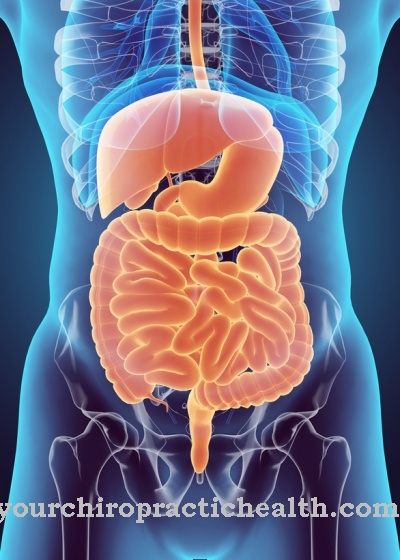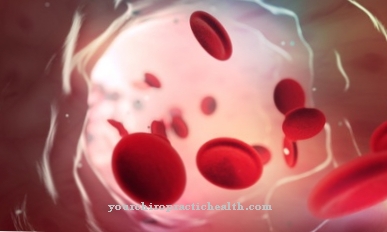evolution means development. In relation to humans, this refers to the development of animal ancestors through ancestral and early humans to today's humans.
The biological name of the species is Homo sapiens.
In biology, a "species" means a community of living beings that can reproduce with one another.
What is evolution

The phylogenetic development of humans can be viewed in connection with the development of vertebrates and mammals. According to the theory formulated by Charles Darwin in the 19th century, species change or species develop under the influence of mutation and selection.
Mutations are accidental changes in the genetic makeup that can be caused, for example, by chemical or physical influences. If these changes affect the reproductive cells, i.e. the egg or sperm cells, they are passed on to the next generation during fertilization.
Most of these mutations are not viable. However, if the mutation does not lead to a life-threatening malfunction in the offspring, it can have beneficial, negative, or even no effect on the individual's ability to survive.
Advantageous mutations can have the effect that the bearer of the new trait is able to assert himself better in the environment and to bring more and more resistant offspring into the world in the course of life. Over time, the new trait would spread through the population through positive selection. This could also be a first step towards a change towards a new species.
Function & task
Remains of the first cell-nucleus-free life forms were found in rock layers from the primeval period. They are over 3 billion years old. The development of increasingly complex forms of life took place in the sea. But it was not until the Cambrian, about 570 million years ago, the beginning of the primeval earth period, that most of the animal tribes living today were apparently present. These include, for example, molluscs such as snails, arthropods such as crabs and cnidarians such as jellyfish and corals. Fossil remains of vertebrates are only known from the Ordovician 500 million years ago.
Soon plants and animals began to colonize the land as well. In the Devonian, about 400 million years ago, amphibians were also the first vertebrates to colonize the country. The first fossils of small mammals are known from the Mesozoic era, the age of the dinosaurs. These presumably had the advantage over the cold-blooded lizards that they could regulate and maintain their body temperature independently. This enabled them to move quickly even at low temperatures. That was an important survival and adaptation benefit. Even today, large lizards and amphibians only occur in warm climates, while mammals have been able to spread to arctic regions.
The mode of reproduction of mammals also represents a decisive evolutionary advantage, because the embryo can develop protected in the mother's body and the offspring are cared for at the beginning.
Half-monkeys are known to have been found in the Cretaceous period around 140 million years ago. After the dinosaurs died out at the end of the Cretaceous period, birds and mammals were able to develop further. They could colonize almost all habitats during the Tertiary about 65 million years ago.
Which line of development led directly to man today can only be inferred by comparing fossil finds. In the case of new finds, older ideas often have to be checked and revised. It is believed that the proconsul or Propliopithecus, who was about the size of a baboon and lived 20 to 30 million years ago, was an ancestor of today's primates, which biologically include humans.
Considered a little bit more slowly, evolution takes place very slowly from generation to generation. All living beings are permanently subject to the influences of the environment, the conditions of which are inscribed in the body almost imperceptibly. The fields of epigenetics and acceleration bear witness to this.
Illnesses & ailments
The further development to humans and the genus Homo possibly also led to the fact that there were lines of development that have become extinct. Sometimes this is suspected in the Neanderthal man (Homo neandertalensis). However, some researchers also assume that it mixed with Homo sapiens and was absorbed into the population.
Typical human characteristics are the upright gait, language, use of tools and the development of cognitive abilities that went hand in hand with the development of the brain. Such abilities can, however, also be found to some extent in animals, as, for example, amazing results of science show, in which the abilities of animals were intensively trained.
One of the triggers of human development may have been the spread of steppes 7.5 million years ago. She favored the upright gait, which gave a better overview. At the same time, hands were free for using and making tools.
The hand has since developed into a specialized gripping tool with which food can be better prepared and processed. A strong jaw was no longer so important and the skull could take up more space.
The alternation of ice ages and warm ages about 2 million years ago at the beginning of the Quaternary made demands on the adaptability of living beings, which humans were particularly good at. He was able to protect himself with suitable clothing and housing and to pass on his experiences as an important wealth of knowledge in the social group.
However, the many advantages of human evolution, which enable us to actively shape our environment today, also brought about difficult changes. One of them is the enlargement of the skull, which leads to the fact that the person is born in pain. So the maximum size for a natural birth has long been reached.
























.jpg)



